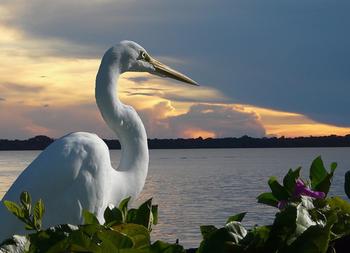Amazon conservation cost pegged at $150 mln a Year
The cost of conserving the Amazon ecosystem has been estimated at US$150 million a year, according to the first joint report by the directors of protected areas in the eight Amazonian countries.
 |
|
Heron surveys Guajara Bay near the city of Belem on the northern edge of the Brazilian Amazon. ? |
The directors presented their estimate at the UN Conference on Biodiversity in Nagoya, which entered its High-level Ministerial Segment today with environment ministers and world leaders from 193 countries in attendance.
This report was the first on putting into practice the Convention on Biodiversity's Program of Work on Protected Areas in the Amazon. The directors also have issued an action plan for the region for the period between 2011 and 2020.
The regional report is the result of the work done by Amazonian countries to set up a conservation strategy that embraces the entire ecosystem in the Amazon. The purpose is to integrate the separate conservation work done by each of the nations whose borders encompass the Amazon biome.
"An integrated view of the Amazon is essential to the achievement of more consistent biodiversity conservation goals with regard to the maintenance of ecological services, the representation of ecosystems, and even resistance to the threats of climate change," said Fabio Franca de Araujo, director of Protected Areas in Brazil.
"We cannot think of the Amazon in Brazil, Colombia, Ecuador, Peru and other countries separately, because biodiversity is far beyond the division between national boundaries," said Maria Fernanda Cuartas of the Special National Natural Parks Unit in Colombia.
The eight Amazonian countries have invested approximately US$100 million a year in the maintenance of protected areas in the Amazon.
But there remains a shortfall of at least US$50 million a year, besides the need for an additional investment in infrastructure of approximately US$500 million in the region's protected areas in order to achieve basic levels of consolidation, the directors reported.
Given the overall importance of the Amazon biome, the Amazonian countries say a significant proportion of the shortfall should be covered by contributions from other governments and international financial institutions.
The Amazon Basin encompasses seven million square kilometers (1.7 billion acres), of which five and a half million square kilometers (1.4 billion acres) are covered by rainforest and filled with unparalleled diversity of life forms.
The region is inhabited by some 2,000 birds and mammals, about 2.5 million insect species, and tens of thousands of plant species. To date, at least 40,000 plant species, 3,000 fish, 1,294 birds, 427 mammals, 428 amphibians, and 378 reptiles have been scientifically classified in the region, and 1,200 new species were documented in the decade from 1999 to 2009, WWF's Living Amazon Initiative reported this week.
The diversity of plant species in the Amazon is the highest on Earth with some experts estimating that one square kilometer may contain more than a thousand types of trees and thousands of species of other plants.
In addition to the Environment Ministers from Amazonian countries invited by Brazil's Environment Minister Izabella Teixeira, the event was attended by representatives of the Latin American National Park Network, Redparques; the International Union for Conservation of Nature; the Convention on Biodiversity; and the WWF's Amazon Initiative, the Community of Andean Nations; and the Amazon Cooperation Treaty Organization.
Since 2009, these organizations have backed the work done by national governments through technical support for the construction of the regional strategy on conservation of the biome and the implementation of the action plan.
One of the drivers of this work is that protected areas are a key tool in any strategy for sustainable development and the conservation of ecological and cultural diversity.
Another is that approximately 21 percent of Brazil's Amazon region is protected, and 26 percent is indigenous land or uses other means of conservation.
More than three-quarters of the world's areas that were protected between 2003 and 2009 are in the Amazon biome, which encompasses 2.16 percent of all the protected areas in the world.
 0
0 






